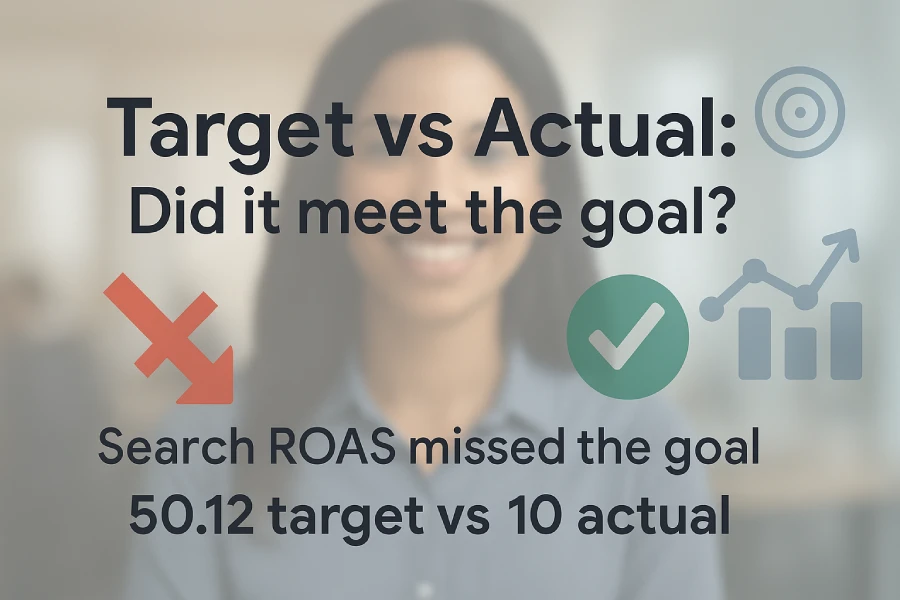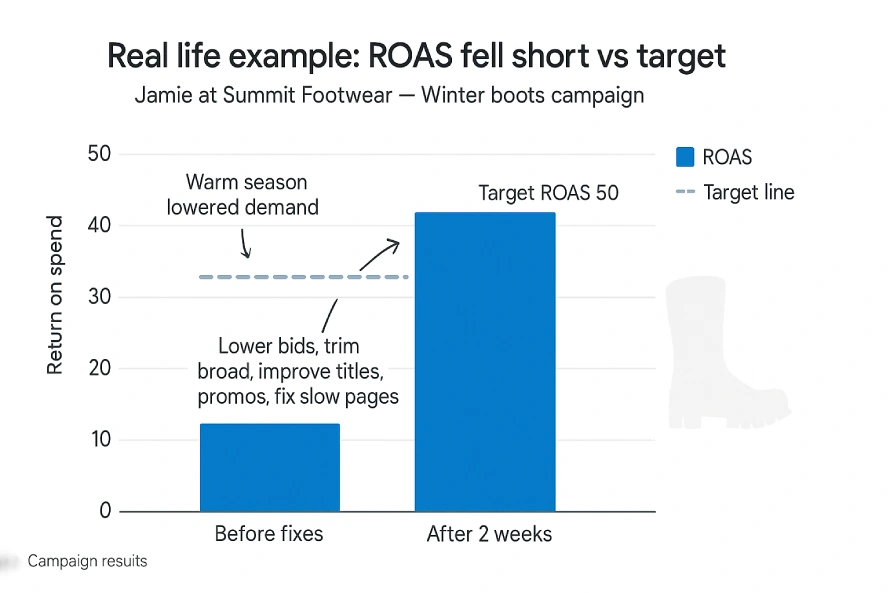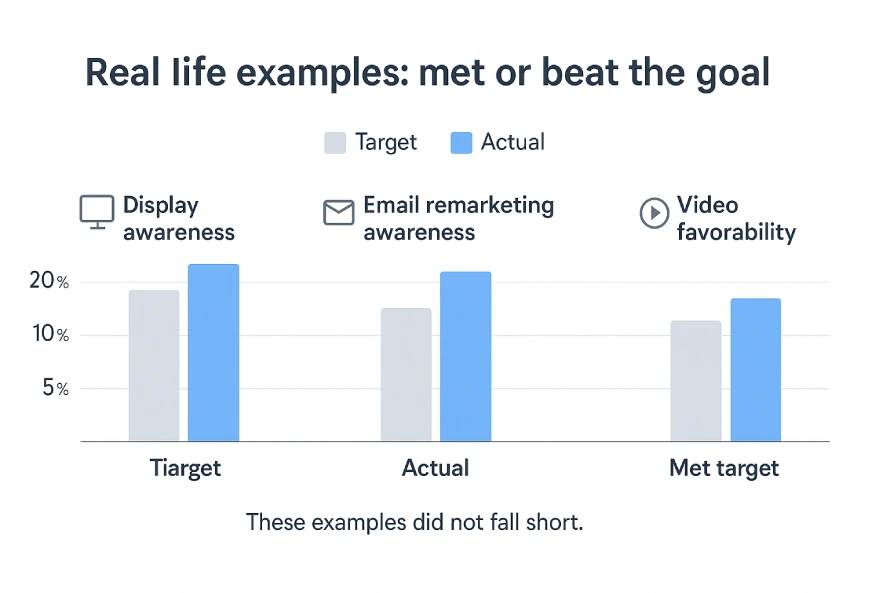The correct answer is “A search campaign with an expected ROAS of 50.12 dollars and an actual ROAS of 10 dollars.” It is correct because the result is below the goal. This guide shows why and why the other options are wrong. It appears in the Google Ads Measurement Certification.
To judge any campaign, compare the target with the actual. If the actual number is lower, the campaign fell short. So no delay. Let’s go explore the details.

Table of Contents
Question
What is an example of a campaign that fell short of its target goal?
A. A display campaign with an expected brand awareness lift of 10% and an actual brand awareness lift of 20%.
B. An email remarketing campaign with an expected lift in brand awareness of 5% and an actual lift in brand awareness of 12%
C. A video campaign with an expected brand favorability lift of 5% and an actual brand favorability lift of 5%.
D. A search campaign with an expected increase in return on ad spend of $50.12 and an actual return on ad spend of $10.
The correct answer
D. A search campaign with an expected increase in return on ad spend of 50.12 dollars and an actual return on ad spend of 10 dollars.
Why the correct answer is right
ROAS tells you how much revenue you earn for each dollar of ad spend. When you set a target, you define what success must look like. The search campaign was expected to return 50.12 dollars for every 1 dollar spent, but it delivered only 10 dollars. That is about one fifth of the planned value.
Because the actual result is far below the target, the goal was not met. In measurement terms, this is a clear miss and a signal to adjust bids, refine keywords, improve creative and landing pages, or pause and rebuild until performance rises.
Real life example for the correct answer
Jamie at Summit Footwear sets a target ROAS of 50 for winter boots. A warm season slows demand. Her search campaign returns only 10 dollars for each dollar spent. Jamie lowers bids, trims broad keywords, improves product titles, adds price promos, and fixes slow pages. After two weeks, ROAS moved toward the goal, but the first run clearly fell short.

Why the other options are wrong
A. Display with expected awareness lift of 10% and actual lift of 20%
This beat the goal. The actual lift is higher than the target, so it did not fall short.
B. Email remarketing with expected awareness lift of 5% and actual lift of 12%
This also beat the goal. The actual lift is more than double the target, so it over delivered.
C. Video with expected favorability lift of 5% and actual lift of 5%
This met the goal. Meeting a goal is not the same as falling short.
Real life examples for the incorrect options
Display that beats the goal
Marcus Lee at BrightCo plans a 10% awareness lift before a launch. The Brand Lift study shows 20%. Marcus keeps the winning creative and placements for the next wave.
Email that beats the goal
Priya Desai at Harbor Home aims for a 5% awareness lift from an email remarketing push. The study shows 12%. Priya expands the list and repeats the message in display and video.
Video that meets the goal
Diego Alvarez at Luna Electronics targets a 5% favorability lift on YouTube. The study returns 5%. Diego treats it as a solid benchmark and tests new openings and captions to push higher next time.

Comparison table
| Option | Target | Actual | Result vs goal | Meets the question |
|---|---|---|---|---|
| Display awareness lift | 10% | 20% | Above target | No |
| Email awareness lift | 5% | 12% | Above target | No |
| Video favorability lift | 5% | 5% | Met target | No |
| Search return on ad spend | 50.12$ | 10$ | Below target | Yes |
Relevant resource links
- About Brand Lift.
- Understand Lift measurement statuses and metrics.
- About Target ROAS bidding.
- Set up conversion tracking for your website.
- Google Ads training and certification on Skillshop.
Conclusion
Start with a clear target, then compare the target to the actual result. If the actual is lower, the campaign fell short. Don’t change metrics, assume success, or skip validation. Define the goal, measure the right KPI, fix gaps, and test again.
I hope you understand the question and how to pick the right option. If you are ready, take the exam on Skillshop for Google Ads Measurement Certification.
FAQs
What does fell short mean in measurement?
It means the actual performance is below the target you set.
Why do brand lift numbers matter?
Brand lift shows if people are more aware of or feel better about your brand after seeing your ads. It helps you measure top-of-funnel impact.
What is return on ad spend in simple words?
Return on ad spend shows how much value you get for each dollar spent on ads. If you spend $1 and earn $5 in value, your return on ad spend is 5.
How should I react if a campaign falls short?
First, check the goal and make sure it matches the campaign type. Then review targeting, bids, budgets, creative, and landing pages. Test changes and measure results.
Can a campaign meet a goal and still need changes?
Yes. Meeting a goal is good, but you can still test new creatives, audiences, and bids to raise results over time.
